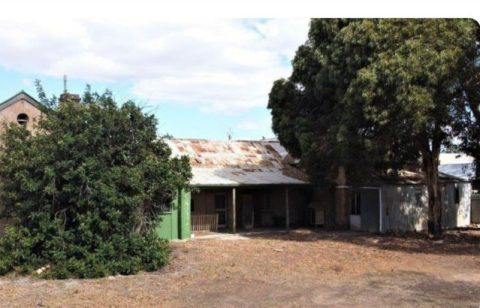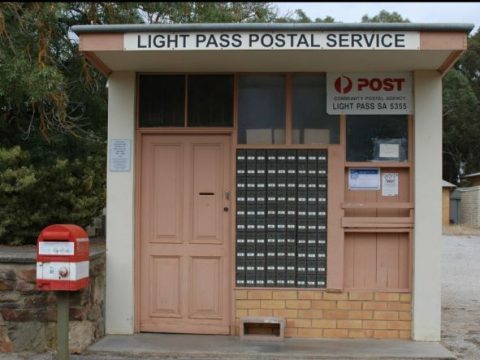Light Pass is a small village, yet it has a wealth of historic buildings, all with a story to tell. You can download the Barossa Heritage Trail App and take a virtual tour or, even better (if you live close enough), take a drive out there. Discover the buildings, stop at the historic wineries, and then go on to Nuriootpa or Angaston for lunch.
 Luhrs Cottage museum
Luhrs Cottage museum
Open Daily 9 am – 4 pm (entry fee: $2)
Luhrs Cottage, in the main street, is also the centre for local history, and has plenty of information available to help you make the most of your visit to Light Pass. It is a fine example of a beautifully restored pug cottage, and a visit here will take you back in time. The cottage contains a wide range of objects and displays that tell the story of how the early Barossa settlers lived. You can also pick up more detailed information here about the different buildings.
 Luhrs Cottage was built by Johann Heinrich Luhrs c 1850, using mud and straw on a framework of red gum. It has four rooms: 2 small bedrooms, a lounge room and a kitchen. There is also a cellar, and various outbuildings including a smokehouse, a machinery shed, and an old long-drop toilet.
Luhrs Cottage was built by Johann Heinrich Luhrs c 1850, using mud and straw on a framework of red gum. It has four rooms: 2 small bedrooms, a lounge room and a kitchen. There is also a cellar, and various outbuildings including a smokehouse, a machinery shed, and an old long-drop toilet.
Read more about the history of the cottage here
 Rechner Cottage
Rechner Cottage
Built in the mid-1800’s, the cottage contains many unique architectural features, and is a rare Australian example of a barnhouse, where accommodation for both people and animals was under one roof. The cottage shows fine German craftsmanship, and is State Heritage listed.
Note: This pug cottage is in the process of being conserved, so people are unable to visit at this time.
 Schiller’s Homestead (Private Residence)
Schiller’s Homestead (Private Residence)
Carl Schiller migrated to Australia from Silesia in 1855, with his wife Caroline and three young children. They settled in Light Pass, and a further seven children were born. Carl was a farmer, and a wide variety of farming activities were carried out on the property. In later years it became a vineyard.
 The Polst Farmhouse and outbuildings. (Private residence)
The Polst Farmhouse and outbuildings. (Private residence)
This complex is an important example of a group of 1860’s farm buildings. The barns and out-buildings are arranged around a central courtyard, so that horses, cows and large wagons could be watered, liveried and housed close to the main dwelling. The property was a highly productive mixed farm and was in the Polst family for over 100 years.
The main house is large, with a main bedroom, kitchen, parlour, laundry and second bedroom, all with fire-places. The locals joked that the high-pitched roof was to keep the snow off! Most likely it was designed as a loft. Under the house are two large cellars.
 Strait Gate Old Manse (Private Residence)
Strait Gate Old Manse (Private Residence)
This fine building was the second manse of the Strait Gate Church, built in 1908 after the old manse was declared unfit for the elderly Bertha Rechner. It was lived in by a succession of pastors and their families, until the new manse was built in 1961.
 Immanuel Lutheran Church and cemetery.
Immanuel Lutheran Church and cemetery.
The Light Pass congregation was established in 1846 by the first settlers. Both faith and education were important for them. A new school was immediately built, and four years later the first church was constructed. It had no floors nor seating – people had to bring their own chairs if they didn’t want to sit on the ground!
With limited medical services available, there was a high mortality rate amongst the early settlers so the cemetery was probably established at the same time as the original church.
The current church was built in 1886. Over the years a sanctuary, vestry and bell tower have been added. The church also has a magnificent pipe organ.

Strait Gate new Church front view
Strait Gate Church and Cemetery
The Strait Gate congregation began in 1860, when a group of 25 families left the Immanuel congregation due to doctrinal differences. The original church and manse (now the Mission House) were built in 1861. The original church was of stone, with a thatched roof, and the bell tower was added in 1874. The new, modernist church was built in 1961, and designed by Erik Von Schramek. It has a beautiful stained-glass window behind the altar, best viewed in the afternoon when it is illuminated by the setting sun. It was created by artist Stan Ostoja Kotkowski
Five of the congregations’ pastors are buried in the cemetery, including GJ Rechner and JJ Stolz, who both played important roles in the Lutheran church. For over 50 years, the small village of Light Pass was the centre of a significant body which helped form the Lutheran Church of Australia.
 The Mission House
The Mission House
The original section of the building was the first manse of the Strait Gate Congregation, built in 1861, and lived in by the Rechner Family until 1908. At this time it was surrounded by a productive smallholding, with fruit trees, vegetable gardens, sheep, cows, pigs and poultry.
It was added to over the years, and adapted for different purposes, including a place for missionaries on furlough to stay, a school, a meeting hall, and private rentals. The congregation and community are now considering how best to preserve and restore this historic building.
 Light Pass Lutheran School
Light Pass Lutheran School
A faith-based education was very important to the early settlers, and the first school was established at the beginning of settlement in 1846. The Immanuel Lutheran School continued until 1909. Under Johann Luhrs and then GJ Rechner, it became an outstanding school in the area, attracting 100 pupils by 1860.
Following the split in the congregation in 1860, the new Strait Gate congregation established its own school. The original pug building opened in 1865. The current school building was built in 1914. In 1917 the South Australian Government closed all German Schools, due to anti-German sentiment as a result of WWI. The building was used by the state education system until, in 1936, the Light Pass congregations decided to reopen the Lutheran School. For a few years they used the Mission House, and then moved back into their original school. A new Lutheran School was built in Nuriootpa in 1982, and the Light Pass school has since been used as a meeting hall for the congregation.
 The Light Pass Post Office
The Light Pass Post Office
This tiny post office is only 3m x 2m, one of the smallest in Australia. It opened in 1960, and is still a great community hub, where locals meet as they collect their mail and check the notice board for community events.
The postal service at Light Pass began in 1905, and was first run by the school teacher. It was attached to his residence, and mail was sorted on the kitchen table. Mail could be collected from the house or taken home by children attending school.
 Light Pass House (Private Residence)
Light Pass House (Private Residence)
Light Pass House was built in 1930 by Ernst Carl Lowke for his Aunt Maria to live in. His father’s will stipulated that a residence be built for his 80 year old sister, who was born deaf and didn’t speak. After Ernst (known as Charlie) retired in 1944, he and his wife moved into Light Pass House. Their son later converted the home into a holiday house, and for many years since the late 90’s it was been a bed & breakfast. It is once again a private residence.
 Light Pass State Primary School
Light Pass State Primary School
The first public school in Light Pass opened in 1917. Initially they used the Lutheran School building, after Lutheran schools were closed by government decree during the war.
In 1939 the Education Department brought the current site from the Lowke family. The school was opened in 1940 (6 years before Lights Pass changed its name to Light Pass). A nice connection is that Johann Lowke was the schoolteacher at Immanuel School from 1866-1909.
 The Willows Hospital and Vineyard (Private residence and cellar door)
The Willows Hospital and Vineyard (Private residence and cellar door)
Johann Scholz established a mixed farm on the banks of the North Para River at Light Pass in 1845. He had been a bone-setter in the Prussian army, and his skills were in high demand in the local area, where specialized medical help was a rarity. With the help of funds from George Fife Angas, he opened the Willows Hospital in 1856, in an extension of the family home. However, word of his successful treatments spread, and demand soon outstripped capacity. A larger 30-bed hospital was opened in 1883. Generations of the Scholz family provided medical care here for over 100 years. The hospital eventually closed in the 1960’s. Read more of its fascinating history here.
Vines have been grown on the property since Johann first settled there in 1845. In1987 the family began producing wines under “The Willows Vineyard” label, and a cellar door now operates on the property.
 Gibson Wines
Gibson Wines
In 1841 Johann Gottleib Steicke and Anne Kowald met and were married on board ship as they emigrated to Australia. They settled in Light Pass and lived in “The Smithy Cottage”, where they raised 10 children. Steicke was a blacksmith, and probably worked for the Sporn family down the road in their blacksmith shop.
The cottage has been beautifully restored. The Gibson winery on the property has a modern cellar door. Bookings preferred (ring 08 8562 4224).
 ‘Willowsporn’ Sporns Farm
‘Willowsporn’ Sporns Farm
Johann Freidrich Sporn emigrated to South Australia in 1844, and moved to Light Pass in 1847, where he built a blacksmith shop. He built his large homestead in 1851. The size and construction suggest he was a successful businessman. By 1880 he owned over 800 acres of land in the region. He was a prominent citizen, on various church committees and a member of the Angaston Council. He continued to work as a blacksmith until his death in 1899.
 Gumpara Bakehouse and Cellar door
Gumpara Bakehouse and Cellar door
This charming bake house was built in the early 1840’s so that fresh-baked breads could be provided to the local Light Pass community, passing trade on Stockwell Road and the nearby ironstone quarry labour force. It was restored in 2020 by the Mader family who have grown grapes on the property for seven generations. Their winery – Gumpara wines – sources all grapes from the property. A cellar door is open for small group tastings by appointment only (Ph. 0419 624 559)
(Information & photos supplied by Darlene Cooper, secretary of Luhrs Cottage & Light Pass)




